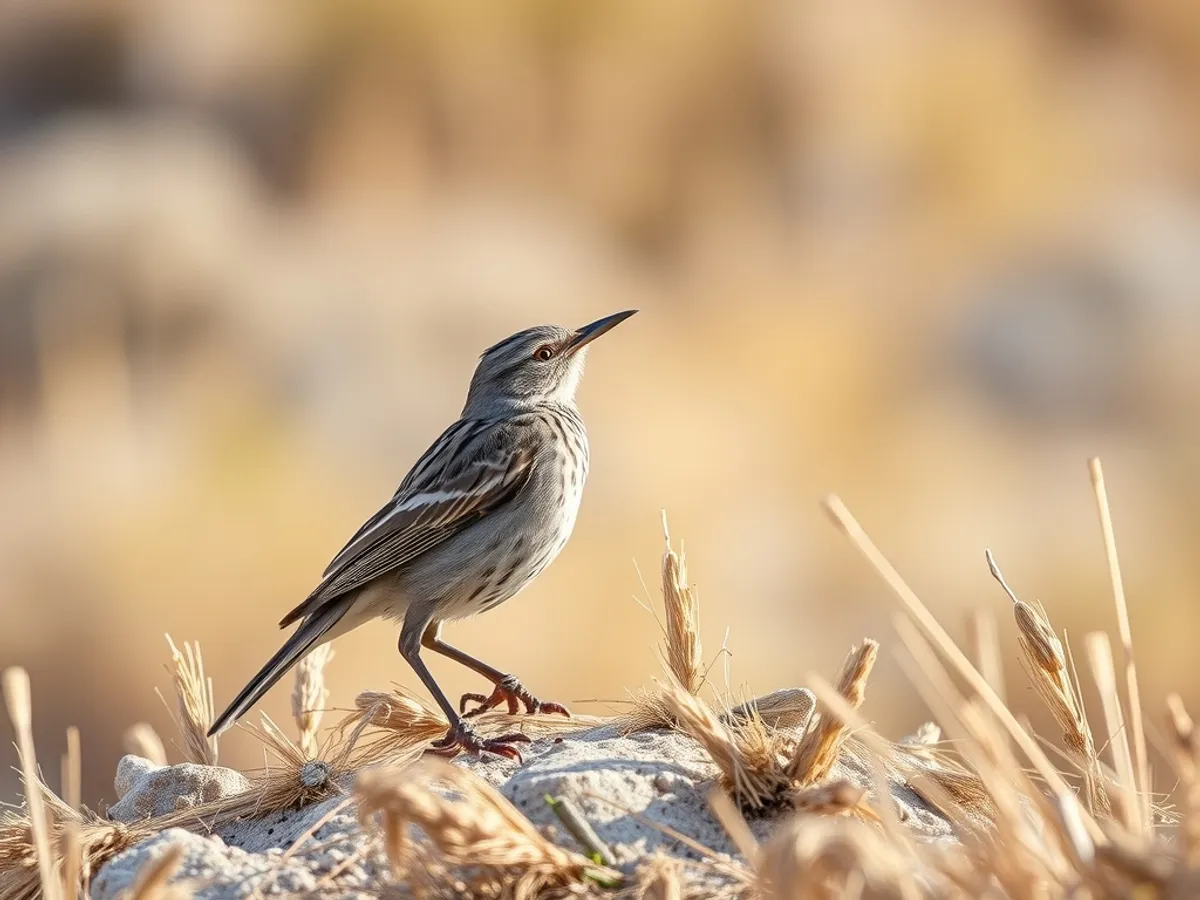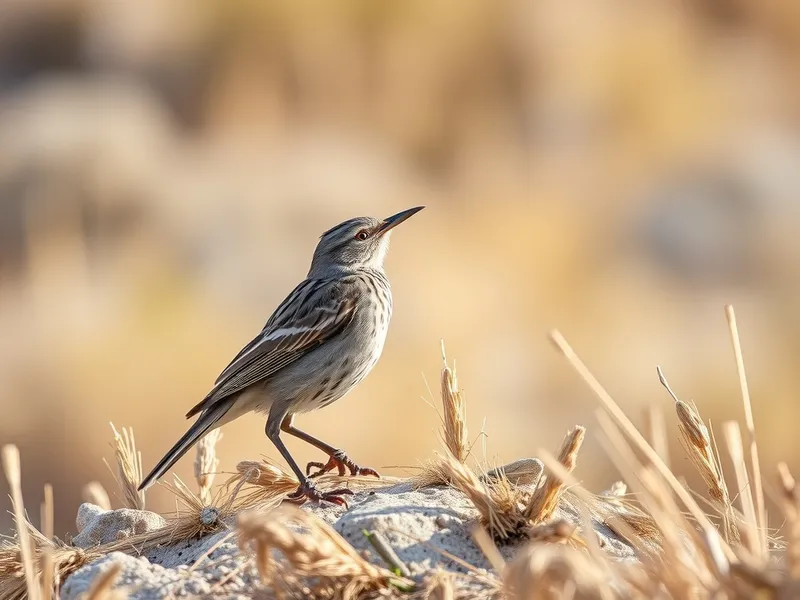
Sage Thrasher
Oreoscoptes montanus

Meet the Sage Thrasher
The Sage Thrasher is a medium-sized songbird known for its slim build, long tail, and pale, streaked plumage. It is highly adapted to the open sagebrush habitats of western North America, where it nests low in dense shrubs. Sage Thrashers are agile foragers, often seen running or hopping on the ground as they search for insects and berries. Their melodious song is a distinctive feature during the breeding season, and males often sing from exposed perches to defend their territory. Despite its subtle coloration, the Sage Thrasher plays a crucial ecological role in sagebrush ecosystems.
Classification
Bird
Habitat
Sagebrush steppe
Diet
Omnivore
Lifespan
5-8 years
Conservation
Least Concern
Weight
32-40 grams
📖Fascinating Facts
Melodious Singer
Male Sage Thrashers are known for their long, complex songs, which they use to attract mates and defend territory during the breeding season.
Sagebrush Specialist
This bird is closely tied to sagebrush ecosystems and rarely occurs far from these habitats, relying on them for food, shelter, and nesting.
Flexible Diet
Sage Thrashers are omnivorous, eating a variety of insects during the breeding season and switching to berries and seeds in the fall and winter.
📋Detailed Description
The Sage Thrasher (Oreoscoptes montanus) is a slender, medium-sized passerine, measuring 20–23 cm (7.9–9.1 in) in length and weighing 35–50 g (1.2–1.8 oz). It has a relatively short, slightly decurved bill, yellowish eyes, and a long, rounded tail edged with white. Its plumage is pale gray-brown above with heavy, dark streaking on the white underparts, providing effective camouflage in sagebrush habitats. The wings are short and rounded, with two faint wing bars. Sage Thrashers are agile ground foragers, using rapid running and hopping to pursue prey. Their melodious, complex song—composed of varied phrases and mimicry—is a key feature during the breeding season, with males singing from prominent perches. Socially, they are generally solitary or found in pairs during breeding, but may form loose flocks outside the breeding season. Nesting occurs low in dense sagebrush, where both sexes participate in nest construction and chick rearing. This species is highly specialized for life in arid sagebrush steppe, exhibiting both behavioral and physiological adaptations to dry environments. Its diet shifts seasonally, with insects dominating in summer and berries and seeds in winter. The Sage Thrasher plays a vital ecological role as both a predator of insects and a disperser of seeds within its ecosystem.
💡 Did you know?
Sage Thrashers are considered an indicator species for the health of sagebrush habitats and are highly sensitive to habitat loss.
🔬Research & Sources
Wikipedia Summary
The sage thrasher is a medium-sized passerine bird from the family Mimidae, which also includes mockingbirds, tremblers, and New World catbirds. It is the only member of the genus Oreoscoptes. This seems less close to the Caribbean thrashers, but rather to the mockingbirds instead.
Last Modified: 4/5/2024
🎭Behavior & Social Structure
Sage Thrashers are primarily terrestrial foragers, using their bills to probe leaf litter and soil for insects, spiders, and other arthropods. They exhibit a characteristic tail-flicking behavior and often run or hop rather than fly when disturbed. During the breeding season, males are highly territorial, singing persistently from exposed perches to attract mates and deter rivals. Courtship involves aerial chases and display flights. Outside of breeding, they may form small, loose flocks, especially during migration or in wintering grounds. Their daily activity peaks in the early morning and late afternoon, coinciding with optimal foraging conditions. Sage Thrashers are known for their alertness and cryptic behavior, often freezing or slipping quietly into dense cover when threatened.
👶Reproduction & Life Cycle
Breeding occurs from late April through July, with timing varying by latitude and elevation. Sage Thrashers are monogamous within a breeding season, and pairs establish territories in dense sagebrush stands. The female constructs a cup-shaped nest, typically 0.5–1.5 meters above ground in sagebrush or other shrubs. Clutch size ranges from 3 to 5 pale blue eggs, which are incubated primarily by the female for 13–17 days. Both parents feed the altricial chicks, which fledge at 10–12 days old. Pairs may raise one or occasionally two broods per season. High nest predation rates from snakes, mammals, and corvids are a significant reproductive challenge.
🛡️Adaptations & Survival
Sage Thrashers exhibit several adaptations to their arid, open habitat. Their cryptic coloration blends with sagebrush, reducing predation risk. The slightly decurved bill is adapted for probing and gleaning insects from foliage and soil. They have efficient kidneys and behavioral adaptations (such as seeking shade and being active during cooler periods) to minimize water loss. Their song repertoire is unusually complex for a thrasher, aiding in territory defense and mate attraction in open environments where sound carries well. Their nesting strategy—placing nests low in dense shrubs—provides concealment from predators and shelter from harsh weather.
📚Research Sources
🎨Cultural Significance
While not a major figure in folklore or mythology, the Sage Thrasher is an important indicator species for the health of sagebrush ecosystems and is valued by birdwatchers for its melodious song. Its presence is often used in ecological monitoring to assess sagebrush habitat integrity. In some Native American traditions, sagebrush and its associated wildlife, including the Sage Thrasher, are respected as part of the natural heritage of the western landscape.
🔬Recent Research & Discoveries
Recent research has focused on the Sage Thrasher's response to habitat fragmentation and climate change, with studies showing sensitivity to the loss of large sagebrush patches. Genetic studies confirm its status as the sole member of its genus, with closest relatives among mockingbirds rather than other thrashers. Bioacoustic research has documented regional variation in song structure, suggesting local adaptation and potential for cultural transmission. Ongoing studies are investigating the effects of invasive plants and altered fire regimes on nesting success and population dynamics.
🎥Wildlife Videos

This Bird Shouldn't Be Here! - Sage Thrasher in Southern Ontario.
Woke up to an exciting bird alert. So in this episode we do a random twitch hours away to Mitchell Bay on Lake St. Clair.
The Bird Bros

Sage Thrasher
Video courtesy of Jim Zipp.
American Bird Conservancy

Sagebrush Sea PBS 2015
Steven Blackwell

Sage Thrasher
Sage Thrasher in Arapaho NWR, Colorado in June. ©JimZipp.com.
Wild Bird and Nature Videos by McElroy Productions

Sage thrasher
Sage thrasher near Prineville OR.
ncglad

Saguaro - The Unexpected Beauty of America's Forgotten National Park | Free Documentary Nature
Saguaro - The Unexpected Beauty of America's Forgotten National Park | Wildlife Documentary Watch 'Yosemite - America's Most ...
Free Documentary - Nature
🌍Habitat Information
The Sage Thrasher typically inhabits Sagebrush steppe environments. Sage Thrashers have adapted to their environments with specialized features and behaviors.
Primary Habitat:
Sagebrush steppe
More detailed habitat information will be available soon.
🛡️Conservation Status
The Sage Thrasher is currently classified as Least Concern. Conservation efforts are crucial for preserving this species for future generations.
Common Threats:
- 🏠Habitat loss and fragmentation
- 🌡️Climate change impacts
- 🎯Hunting and poaching
- 🏭Human-wildlife conflict
⚠️Threats & Conservation Challenges
The primary threat to Sage Thrashers is habitat loss and fragmentation due to agricultural conversion, urban development, energy extraction, and invasive plant species (notably cheatgrass) that alter sagebrush ecosystems. Fire suppression and altered fire regimes can also degrade habitat quality. Pesticide use may reduce insect prey availability. Despite these threats, the species remains widespread and is currently listed as Least Concern by the IUCN, but local declines have been noted where sagebrush is heavily impacted. Long-term conservation depends on the preservation and restoration of large, contiguous sagebrush habitats.
🔬Scientific Classification
Scientific Name
Oreoscoptes montanus
Classification Hierarchy
🔍 About Taxonomic Classification
Taxonomic classification is a hierarchical system used by scientists to classify and organize living organisms based on shared characteristics and evolutionary relationships.
The system moves from broad categories (Kingdom) to increasingly specific ones, with each animal's scientific name typically consisting of its Genus and species.
📝Community Notes
Share your observations and insights about the Sage Thrasher with our community of wildlife enthusiasts.
Join Our Community
Sign in to share your observations and connect with fellow wildlife enthusiasts.
Sign In to ContributeNo community notes yet
Be the first to share your observations about the Sage Thrasher!
Explore Sage Thrasher
Select a tab above to learn more about this amazing animal.
📸Photo Gallery
No photos available for this animal yet.
🌟Discover More Wildlife
Continue your journey of discovery with more fascinating animals from our database
